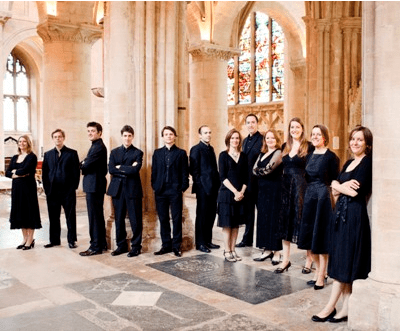
It’s frenetic, this time of year. We are all so busy, caught up in the whirlwind of finding gifts, planning or going to parties, baking and welcoming visitors, flying out, worrying about the budget, and coping simultaneously with everyday life. It’s almost too much.
Taking time out to go to a concert of exquisite music written for the season between four and five hundred years ago may not sound eminently sensible, but it is. Large numbers of people did so Saturday night, filling St. James Cathedral to hear the young British group of thirteen conductorless singers, Stile Antico, presented by the Early Music Guild.
It felt like being suspended in an oasis for a couple of hours, and being reminded that this is not, at heart, merely a month of crass commercialism, but a religious celebration. For all, church or non-churchgoers, it started the season in an affirmation of its meaning.
The heart of the program was an incomplete Mass, Puer natus est, by Thomas Tallis, interspersed with other settings for Advent and Christmas by William Byrd, Robert White, John Taverner, and John Sheppard.
From unison plainchant which ebbed and flowed like speech, to seven intricate, complex parts for the Tallis, Stile Antico sang unaccompanied with exact pitch and no vibrato so that chords were marvels of perfection. It was sometimes hard to hear words from the back of the cathedral, but often that was less important than hearing the interweaving of the polyphonic lines and the harmonies when they all came together.
All of the music was of praise, like the White Magnificat, and the Byrd Tollite portas (“Lift up your gates”), or prayerful, like the sublime Agnus Dei from the Tallis Mass.
The plainchant, mostly sung by the men, sounded rich and purposeful; that by the women, just the Audivi vocem de caelo (“I heard a voice from heaven”) by Taverner, pure and soaring. There was much throughout that was extremely high for the sopranos, whose voices never flagged or lost pitch, but reached the rafters seemingly without effort.
While many of the men might have had rigorous training as children in England’s firstclass choir schools, the women most likely didn’t in quite that way. However, unless you listened very carefully, it would be hard to say if it was woman or boy singing here. Perhaps there is an added energy to boys’ voices, as with their smaller bodies they have to sing out more, where women’s sound may be smoother, but no less clear.
It would be hard to hear any English cathedral choir singing this music any more beautifully that was done by Stile Antico. This was their first visit to Seattle, for a one-night performance, so you will have to wait to hear them again–unless you’re able to get to Chan Centre at UBC, in Vancouver, BC, by 8 p.m. tonight.
